Dynamic Evaluation of Ecological Environment Quality in Coastal Cities from the Perspective of Water Quality: The Case of Fuzhou City
Abstract
:1. Introduction
2. Materials and Methods
2.1. Research Area
2.2. Data
2.2.1. Satellite Data
2.2.2. Land Use Data
2.3. Methods
2.3.1. Construction of the WBEI
- (1)
- Water ecological factors
- (2)
- Landcover index
- (3)
- Entropy method
2.3.2. Sen-MK Slope Analysis
2.3.3. Land Use Dynamics Analysis
3. Results
3.1. Comparison of WBEI and RSEI
3.2. Spatial and Temporal Characteristics and Trends of WBEI
3.3. Relationship between Land Use Change and WBEI
4. Discussion
5. Conclusions
- (1)
- Fuzhou City is a coastal city in southeast China, and the WBEI takes into account the ecological benefits of water and is a more accurate reflection of the differences in ecological patterns in the city than the RSEI. In terms of value distribution, the RSEI is more concentrated in Fuzhou as a whole, while the WBEI values are more evenly distributed, better reflecting the quality of the ecological environment within the city. Spatially, the WBEI is lower than the RSEI in urban built-up areas; in mountainous areas, the WBEI is higher than the RSEI.
- (2)
- The trends in ecological and environmental quality in Fuzhou over the past 20 years were analyzed using the Sen-MK trend analysis method. In general, the ecological environment quality of Fuzhou City as a whole is improving, with the area of improving trend accounting for 7.96% more than the area of degradation trend. In terms of spatial distribution, there is a declining trend in ecological and environmental quality in the mountainous areas in the northeast, but it is not obvious. In the south, there are scattered areas where the quality of the ecological environment has increased significantly.
- (3)
- All types of land in Fuzhou City underwent some transfer from 2000 to 2020. The surface area of man-made land is increasing and growing faster than other land types, mainly from the transfer of cultivated land and forest. Forests show a trend of decreasing and then increasing, mainly to grass and cultivated land. Combining the SLCs, ILCs, and WBEIs of different land categories, forests are an important positive factor in improving Fuzhou City, and the high-intensity increase in artificial surfaces will lead to a decrease in ecological environment quality.
Author Contributions
Funding
Institutional Review Board Statement
Informed Consent Statement
Data Availability Statement
Conflicts of Interest
References
- Alberti, M.; Booth, D.; Hill, K.; Coburn, B.; Avolio, C.; Coe, S.; Spirandelli, D. The Impact of Urban Patterns on Aquatic Ecosystems: An Empirical Analysis in Puget Lowland Sub-Basins. Landsc. Urban Plan. 2007, 80, 345–361. [Google Scholar] [CrossRef]
- Guo, L.; Liu, R.; Men, C.; Wang, Q.; Miao, Y.; Zhang, Y. Quantifying and Simulating Landscape Composition and Pattern Impacts on Land Surface Temperature: A Decadal Study of the Rapidly Urbanizing City of Beijing, China. Sci. Total Environ. 2019, 654, 430–440. [Google Scholar] [CrossRef]
- Hou, Y.; Ding, W.; Liu, C.; Li, K.; Cui, H.; Liu, B.; Chen, W. Influences of Impervious Surfaces on Ecological Risks and Controlling Strategies in Rapidly Urbanizing Regions. Sci. Total Environ. 2022, 825, 153823. [Google Scholar] [CrossRef]
- Lu, S.; Lin, C.; Lei, K.; Wang, B.; Xin, M.; Gu, X.; Cao, Y.; Liu, X.; Ouyang, W.; He, M. Occurrence, Spatiotemporal Variation, and Ecological Risk of Antibiotics in the Water of the Semi-Enclosed Urbanized Jiaozhou Bay in Eastern China. Water Res. 2020, 184, 116187. [Google Scholar] [CrossRef] [PubMed]
- Bai, J.; Guo, K.; Liu, M.; Jiang, T. Spatial Variability, Evolution, and Agglomeration of Eco-Environmental Risks in the Yangtze River Economic Belt, China. Ecol. Indic. 2023, 152, 110375. [Google Scholar] [CrossRef]
- Gao, M.; Chen, B.; Xu, Y.; Li, D. Heterogeneous Impacts of Global Land Urbanization on Land-Use Structure from Economic and Technological Perspectives. Ecol. Indic. 2023, 147, 109955. [Google Scholar] [CrossRef]
- Yu, G.; Liu, T.; Wang, Q.; Li, T.; Li, X.; Song, G.; Feng, Y. Impact of Land Use/Land Cover Change on Ecological Quality during Urbanization in the Lower Yellow River Basin: A Case Study of Jinan City. Remote Sens. 2022, 14, 6273. [Google Scholar] [CrossRef]
- He, W.; Li, X.; Yang, J.; Ni, H.; Sang, X. How Land Use Functions Evolve in the Process of Rapid Urbanization: Evidence from Jiangsu Province, China. J. Clean. Prod. 2022, 380, 134877. [Google Scholar] [CrossRef]
- Perez Lopez, I.; Martin, D.J. Rethinking Estuary Urbanism—Preparing Australian Estuary Cities for Changes to Come in the Climate and Biodiversity Emergency. Sustainability 2023, 15, 962. [Google Scholar] [CrossRef]
- Miroshnyk, N.V.; Likhanov, A.F.; Grabovska, T.O.; Teslenko, I.K.; Roubík, H. Green Infrastructure and Relationship with Urbanization—Importance and Necessity of Integrated Governance. Land Use Policy 2022, 114, 105941. [Google Scholar] [CrossRef]
- Callaghan, C.T.; Liu, G.; Mitchell, B.A.; Poore, A.G.B.; Rowley, J.J.L. Urbanization Negatively Impacts Frog Diversity at Continental, Regional, and Local Scales. Basic Appl. Ecol. 2021, 54, 64–74. [Google Scholar] [CrossRef]
- Yang, C.; Wang, W.; Liang, Z.; Wang, Y.; Chen, R.; Liang, C.; Wang, F.; Li, P.; Ma, L.; Wei, F.; et al. Regional Urbanicity Levels Modify the Association between Ambient Air Pollution and Prevalence of Obesity: A Nationwide Cross-Sectional Survey. Environ. Pollut. 2023, 320, 121079. [Google Scholar] [CrossRef] [PubMed]
- He, Q.; Wang, Y.; Qiu, Q.; Su, Y.; Wang, Y.; Wei, H.; Li, J. Joint Effects of Air PM2.5 and Socioeconomic Dimensions on Posted Emotions of Urban Green Space Visitors in Cities Experiencing Population Urbanization: A Pilot Study on 50 Cities of East China. Sci. Total Environ. 2023, 861, 160607. [Google Scholar] [CrossRef] [PubMed]
- Liu, R.; Dong, X.; Wang, X.; Zhang, P.; Liu, M.; Zhang, Y. Relationship and Driving Factors between Urbanization and Natural Ecosystem Health in China. Ecol. Indic. 2023, 147, 109972. [Google Scholar] [CrossRef]
- Na, L.; Zhao, Y.; Guo, L. Coupling Coordination Analysis of Ecosystem Services and Urbanization in Inner Mongolia, China. Land 2022, 11, 1870. [Google Scholar] [CrossRef]
- Wang, H.; Wang, L.; Yang, Q.; Fu, X.; Guo, M.; Zhang, S.; Wu, D.; Zhu, Y.; Wu, G. Interaction between Ecosystem Service Supply and Urbanization in Northern China. Ecol. Indic. 2023, 147, 109923. [Google Scholar] [CrossRef]
- Shang, Y.; Liu, S. Spatial-Temporal Coupling Coordination Relationship between Urbanization and Green Development in the Coastal Cities of China. Sustainability 2021, 13, 5339. [Google Scholar] [CrossRef]
- Park, H.; Paterson, R.; Zigmund, S.; Shin, H.; Jang, Y.; Jung, J. The Effect of Coastal City Development on Flood Damage in South Korea. Sustainability 2020, 12, 1854. [Google Scholar] [CrossRef] [Green Version]
- Shan, Q. The Influence of Trade Agglomeration on Technology Diffusion in Coastal Cities in Different Time and Space. J. Coast. Res. 2020, 103, 543–547. [Google Scholar] [CrossRef]
- Sun, R.; Wu, Z.; Chen, B.; Yang, C.; Qi, D.; Lan, G.; Fraedrich, K. Effects of Land-Use Change on Eco-Environmental Quality in Hainan Island, China. Ecol. Indic. 2020, 109, 105777. [Google Scholar] [CrossRef]
- Ye, Y.; Wang, Y.; Liao, J.; Chen, J.; Zou, Y.; Liu, Y.; Feng, C. Spatiotemporal Pattern Analysis of Land Use Functions in Contiguous Coastal Cities Based on Long-Term Time Series Remote Sensing Data: A Case Study of Bohai Sea Region, China. Remote Sens. 2022, 14, 3518. [Google Scholar] [CrossRef]
- Zhang, W.; Chang, W.J.; Zhu, Z.C.; Hui, Z. Landscape Ecological Risk Assessment of Chinese Coastal Cities Based on Land Use Change. Appl. Geogr. 2020, 117, 102174. [Google Scholar] [CrossRef]
- Xu, C.; Jiang, W.; Huang, Q.; Wang, Y. Ecosystem Services Response to Rural-Urban Transitions in Coastal and Island Cities: A Comparison between Shenzhen and Hong Kong, China. J. Clean. Prod. 2020, 260, 121033. [Google Scholar] [CrossRef]
- Baró, F.; Gómez-Baggethun, E.; Haase, D. Ecosystem Service Bundles along the Urban-Rural Gradient: Insights for Landscape Planning and Management. Ecosyst. Serv. 2017, 24, 147–159. [Google Scholar] [CrossRef] [Green Version]
- Yan, Z.; You, N.; Wang, L.; Lan, C. Assessing the Impact of Road Network on Urban Landscape Ecological Risk Based on Corridor Cutting Degree Model in Fuzhou, China. Sustainability 2023, 15, 1724. [Google Scholar] [CrossRef]
- Munizaga, J.; García, M.; Ureta, F.; Novoa, V.; Rojas, O.; Rojas, C. Mapping Coastal Wetlands Using Satellite Imagery and Machine Learning in a Highly Urbanized Landscape. Sustainability 2022, 14, 5700. [Google Scholar] [CrossRef]
- Zhang, G. Landscape Design of Adaptable Gardens to Flood Disasters in Coastal Cities. Fresenius Environ. Bull. 2022, 31, 5955–5960. [Google Scholar]
- Yılmaz, M.; Terzi, F. Quantitative Spatial Assessment of the Impact of Urban Growth on the Landscape Network of Türkiye’s Coastal Cities. Environ. Monit Assess 2023, 195, 466. [Google Scholar] [CrossRef]
- Zhu, Z.; Zhou, Y.; Seto, K.C.; Stokes, E.C.; Deng, C.; Pickett, S.T.A.; Taubenböck, H. Understanding an Urbanizing Planet: Strategic Directions for Remote Sensing. Remote Sens. Environ. 2019, 228, 164–182. [Google Scholar] [CrossRef]
- Du, P.; Liu, P.; Xia, J.; Feng, L.; Liu, S.; Tan, K.; Cheng, L. Remote Sensing Image Interpretation for Urban Environment Analysis: Methods, System and Examples. Remote Sens. 2014, 6, 9458–9474. [Google Scholar] [CrossRef] [Green Version]
- Duan, C.; Zheng, X.; Jin, L.; Chen, Y.; Li, R.; Yang, Y. Study on the Remote Sensing Spectral Method for Disaster Loss Inversion in Urban Flood Areas. Water 2022, 14, 2165. [Google Scholar] [CrossRef]
- Xu, H.; Wang, Y.; Guan, H.; Shi, T.; Hu, X. Detecting Ecological Changes with a Remote Sensing Based Ecological Index (RSEI) Produced Time Series and Change Vector Analysis. Remote Sens. 2019, 11, 2345. [Google Scholar] [CrossRef] [Green Version]
- Sun, C.; Li, J.; Liu, Y.; Cao, L.; Zheng, J.; Yang, Z.; Ye, J.; Li, Y. Ecological Quality Assessment and Monitoring Using a Time-Series Remote Sensing-Based Ecological Index (Ts-RSEI). GISci. Remote Sens. 2022, 59, 1793–1816. [Google Scholar] [CrossRef]
- Chen, Z.; Chen, R.; Guo, Q.; Hu, Y. Spatiotemporal Change of Urban Ecologic Environment Quality Based on RSEI—Taking Meizhou City, China as an Example. Sustainability 2022, 14, 13424. [Google Scholar] [CrossRef]
- Wen, X.; Ming, Y.; Gao, Y.; Hu, X. Dynamic Monitoring and Analysis of Ecological Quality of Pingtan Comprehensive Experimental Zone, a New Type of Sea Island City, Based on RSEI. Sustainability 2020, 12, 21. [Google Scholar] [CrossRef] [Green Version]
- Zhang, Y.; Jiang, F. Developing a Remote Sensing-Based Ecological Index Based on Improved Biophysical Features. J. Appl. Rem. Sens. 2021, 16, 012008. [Google Scholar] [CrossRef]
- Yang, W.; Zhou, Y.; Li, C. Assessment of Ecological Environment Quality in Rare Earth Mining Areas Based on Improved RSEI. Sustainability 2023, 15, 2964. [Google Scholar] [CrossRef]
- Bai, Z.; Han, L.; Liu, H.; Jiang, X.; Li, L. Spatiotemporal Change and Driving Factors of Ecological Status in Inner Mongolia Based on the Modified Remote Sensing Ecological Index. Environ. Sci. Pollut. Res. 2023, 30, 52593–52608. [Google Scholar] [CrossRef]
- Shi, F.; Yang, B.; Li, M. An Improved Framework for Assessing the Impact of Different Urban Development Strategies on Land Cover and Ecological Quality Changes -A Case Study from Nanjing Jiangbei New Area, China. Ecol. Indic. 2023, 147, 109998. [Google Scholar] [CrossRef]
- Liao, W. Temporal and Spatial Variations of Eco-Environment in Association of Southeast Asian Nations from 2000 to 2021 Based on Information Granulation. J. Clean Prod. 2022, 373, 133890. [Google Scholar] [CrossRef]
- Yang, X.; Meng, F.; Fu, P.; Zhang, J.; Liu, Y. Instability of Remote Sensing Ecological Index and Its Optimisation for Time Frequency and Scale. Ecol. Inform. 2022, 72, 101870. [Google Scholar] [CrossRef]
- Jiao, Z.; Sun, G.; Zhang, A.; Jia, X.; Huang, H.; Yao, Y. Water Benefit-Based Ecological Index for Urban Ecological Environment Quality Assessments. IEEE J. Sel. Top. Appl. Earth Obs. Remote Sens. 2021, 14, 7557–7569. [Google Scholar] [CrossRef]
- Hu, X.; Xu, H. A New Remote Sensing Index for Assessing the Spatial Heterogeneity in Urban Ecological Quality: A Case from Fuzhou City, China. Ecol. Indic. 2018, 89, 11–21. [Google Scholar] [CrossRef]
- Przezdziecki, K.; Zawadzki, J. Impact of the Variability of Vegetation, Soil Moisture, and Building Density between City Districts on Land Surface Temperature, Warsaw, Poland. Sustainability 2023, 15, 1274. [Google Scholar] [CrossRef]
- Sarif, M.O.; Gupta, R.D.; Murayama, Y. Assessing Local Climate Change by Spatiotemporal Seasonal LST and Six Land Indices, and Their Interrelationships with SUHI and Hot-Spot Dynamics: A Case Study of Prayagraj City, India (1987–2018). Remote Sens. 2023, 15, 179. [Google Scholar] [CrossRef]
- Seletkovic, A.; Kicic, M.; Ancic, M.; Kolic, J.; Pernar, R. The Urban Heat Island Analysis for the City of Zagreb in the Period 2013-2022 Utilizing Landsat 8 Satellite Imagery. Sustainability 2023, 15, 3963. [Google Scholar] [CrossRef]
- Liang, L.; Di, L.; Zhang, L.; Deng, M.; Qin, Z.; Zhao, S.; Lin, H. Estimation of Crop LAI Using Hyperspectral Vegetation Indices and a Hybrid Inversion Method. Remote Sens. Environ. 2015, 165, 123–134. [Google Scholar] [CrossRef]
- Li, J. Evaluation Method of Ecological Vulnerability of Scenic Spots Based on Entropy Weight TOPSIS Model. Int. J. Environ. Technol. Manag. 2023, 26, 14–26. [Google Scholar] [CrossRef]
- Guo, Y.; Ma, X.; Zhu, Y.; Chen, D.; Zhang, H. Research on Driving Factors of Forest Ecological Security: Evidence from 12 Provincial Administrative Regions in Western China. Sustainability 2023, 15, 5505. [Google Scholar] [CrossRef]
- Chen, C.; Zhang, H. Evaluation of Green Development Level of Mianyang Agriculture, Based on the Entropy Weight Method. Sustainability 2023, 15, 7589. [Google Scholar] [CrossRef]
- Sun, K.; He, W.; Shen, Y.; Yan, T.; Liu, C.; Yang, Z.; Han, J.; Xie, W. Ecological Security Evaluation and Early Warning in the Water Source Area of the Middle Route of South-to-North Water Diversion Project. Sci. Total Environ. 2023, 868, 161561. [Google Scholar] [CrossRef]
- Gao, P.; Wang, X.; Wang, H.; Cheng, C. Viewpoint: A Correction to the Entropy Weight Coefficient Method by Shen et al. for Accessing Urban Sustainability [Cities 42 (2015) 186–194]. Cities 2020, 103, 102742. [Google Scholar] [CrossRef]
- Qi, J.; Zhang, Y.; Zhang, J.; Wu, C.; Chen, Y.; Cheng, Z. Study on the Restoration of Ecological Environments in Mining Area Based on GIS Technology. Sustainability 2023, 15, 6128. [Google Scholar] [CrossRef]
- Zhang, L.; Fang, C.; Zhao, R.; Zhu, C.; Guan, J. Spatial-Temporal Evolution and Driving Force Analysis of Eco-Quality in Urban Agglomerations in China. Sci. Total Environ. 2023, 866, 161465. [Google Scholar] [CrossRef] [PubMed]
- Chen, Q.; Mao, Y.; Morrison, A.M. The Influence of Land Use Evolution on the Visitor Economy in Wuhan from the Perspective of Ecological Service Value. Land 2022, 11, 1. [Google Scholar] [CrossRef]
- Long, H.; Qu, Y. Land Use Transitions and Land Management: A Mutual Feedback Perspective. Land Use Policy 2018, 74, 111–120. [Google Scholar] [CrossRef]
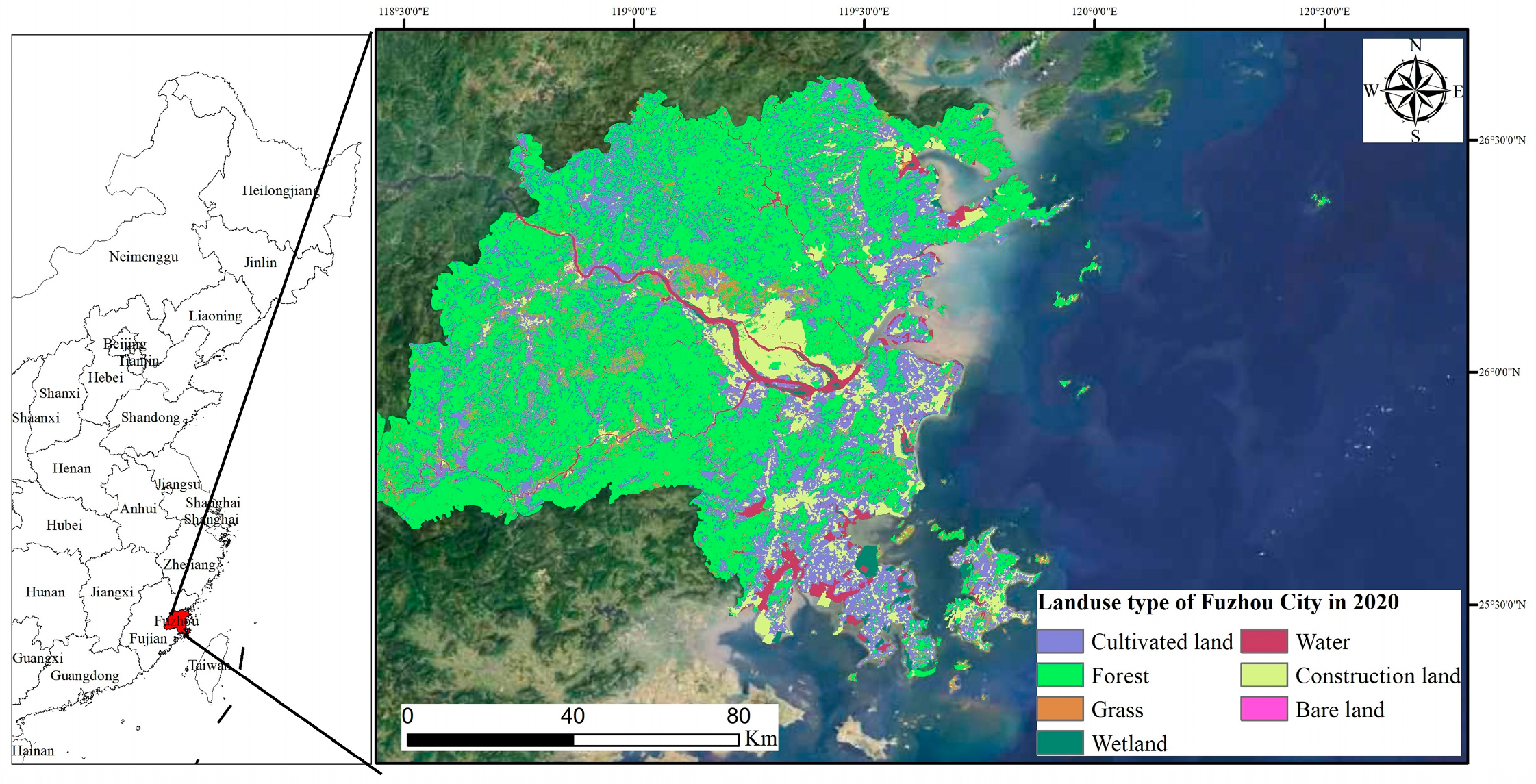
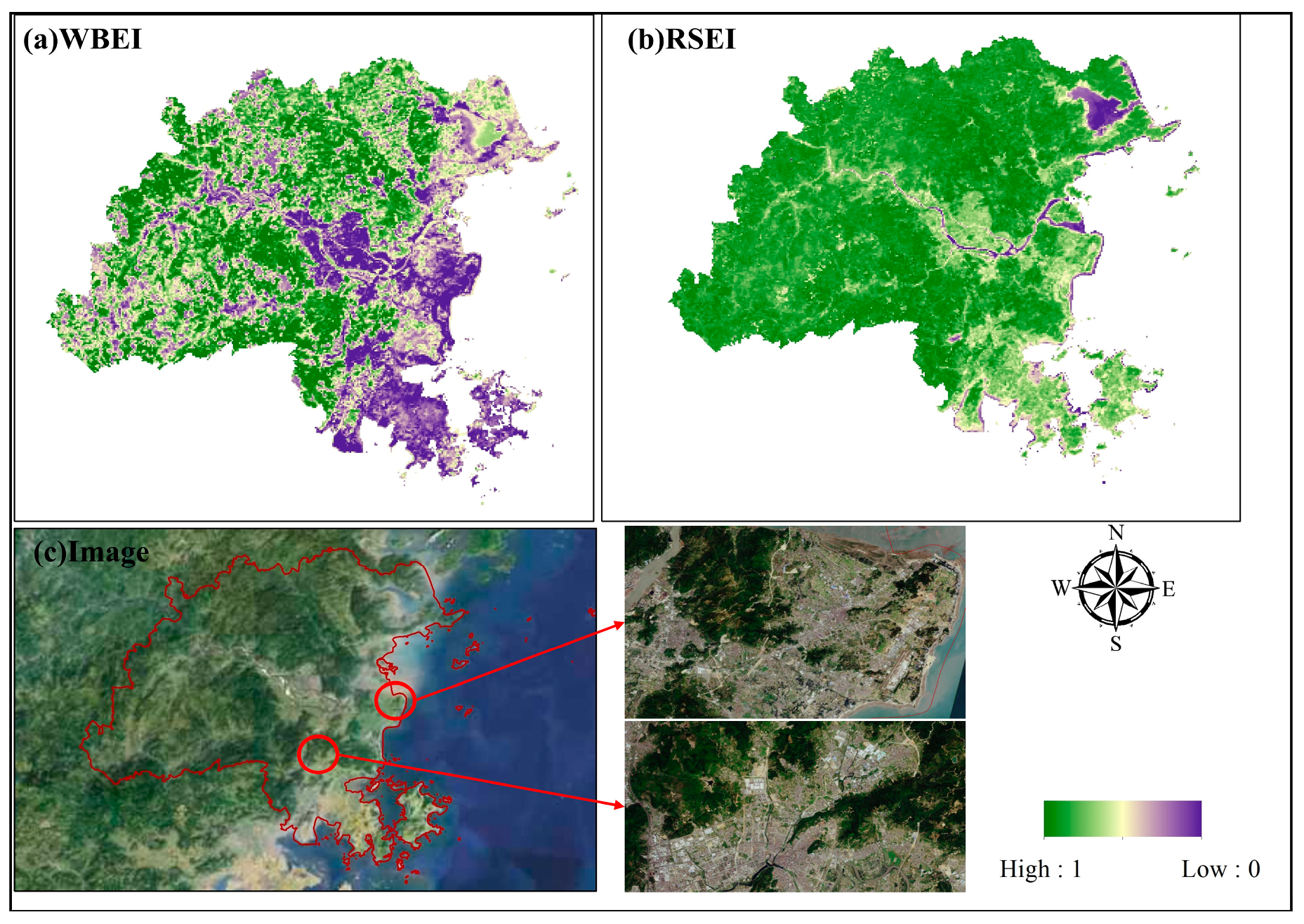
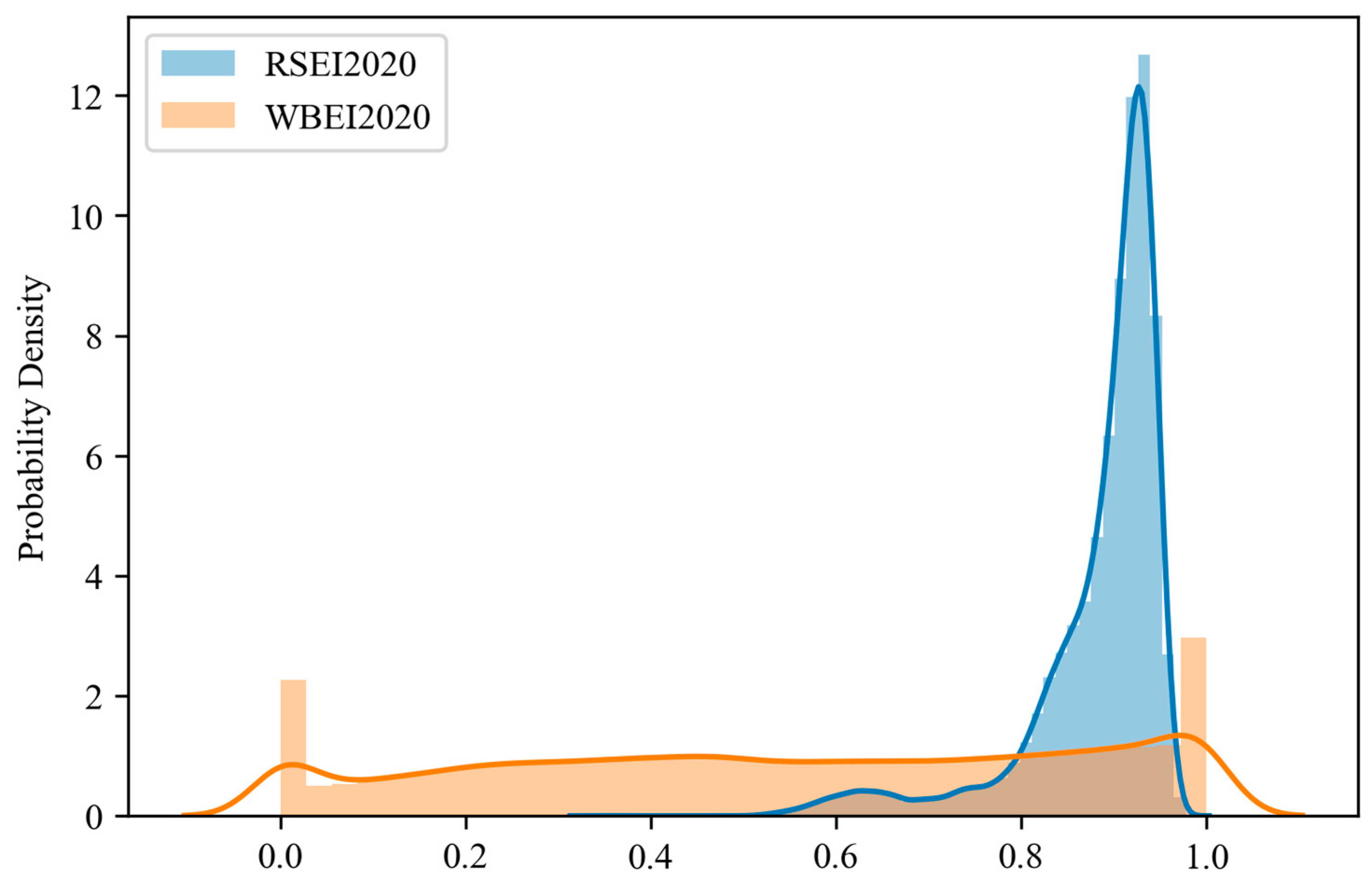

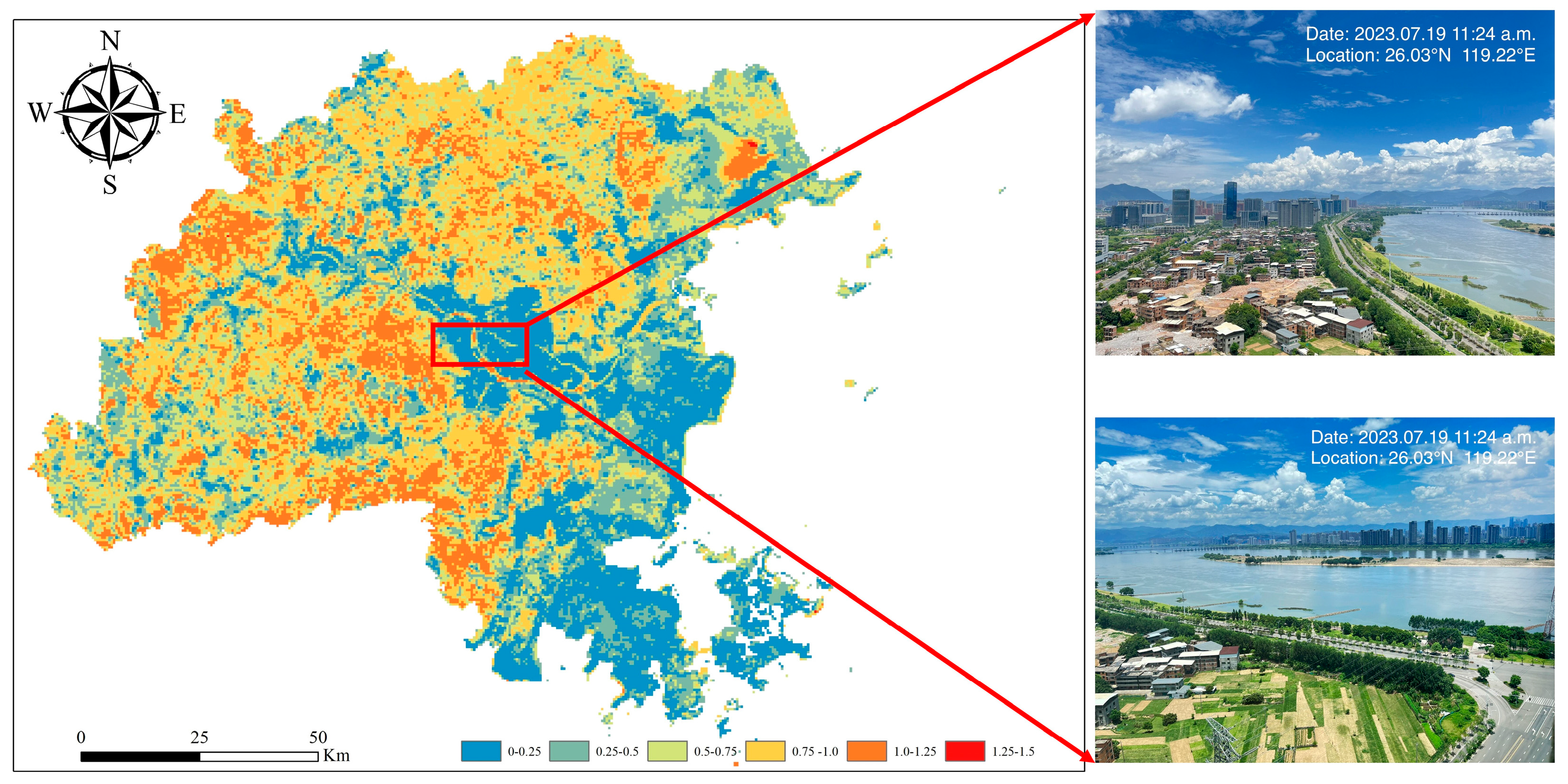

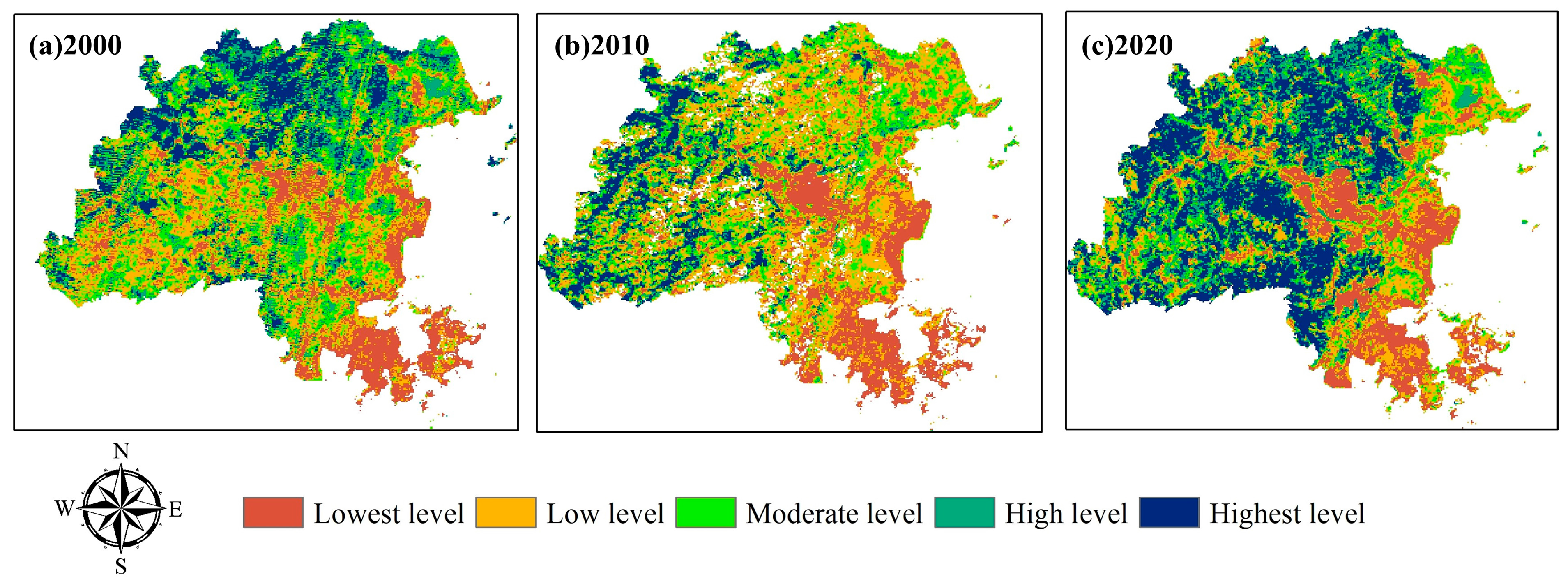
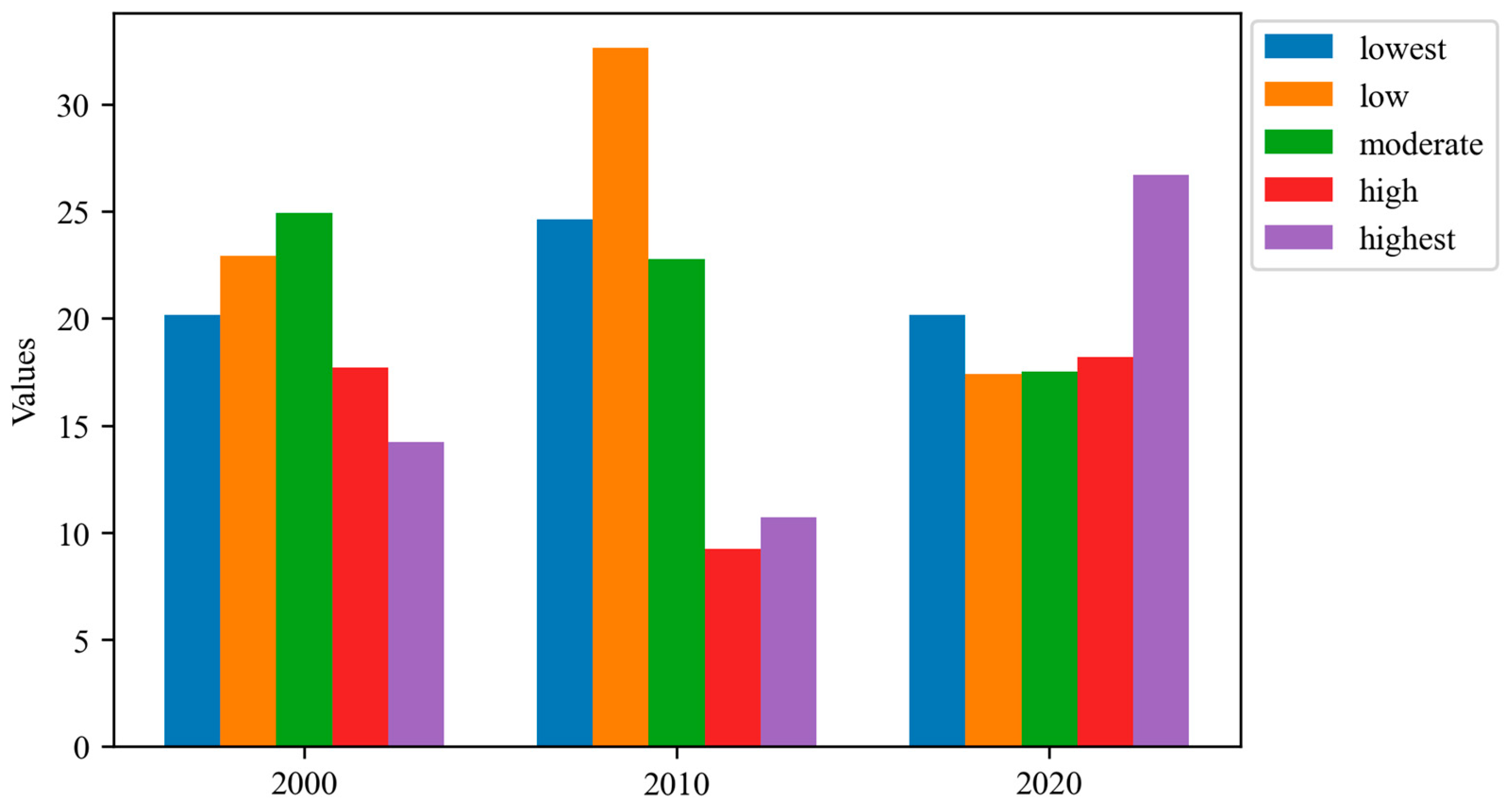




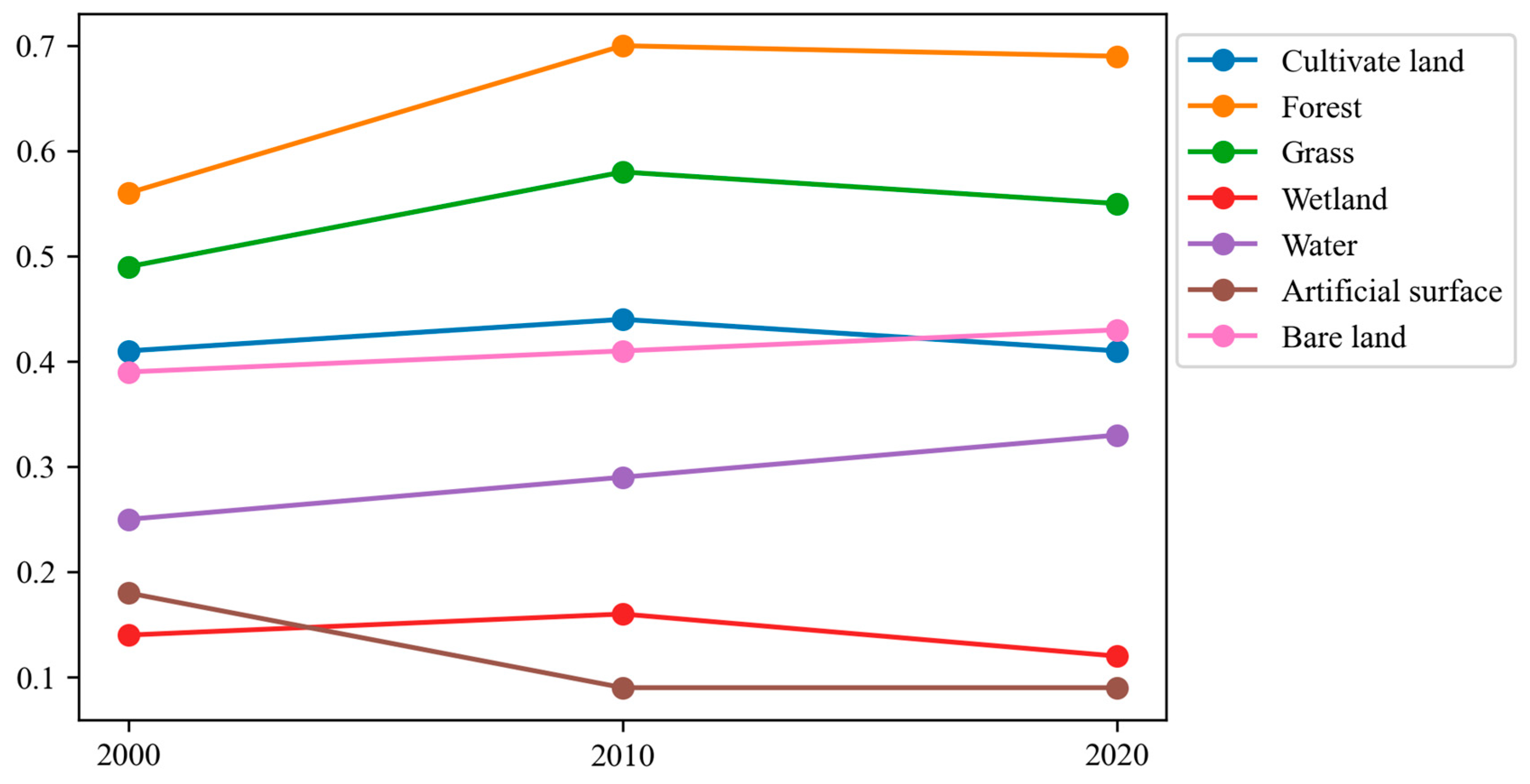
| Delineated Intervals | Ecological Quality Levels |
|---|---|
| [0, 0.2) | Lowest level |
| [0.2, 0.4) | Low level |
| [0.4, 0.6) | Moderate level |
| [0.6, 0.8) | High level |
| [0.8, 1.0) | Highest level |
| Sen-MK Trend | Sen > 0 | Sen < 0 |
|---|---|---|
| |Z| > 1.96 | Significant increase (S-increase) | Significant decrease (S-decrease) |
| |Z| < 1.96 | Not significant increase (NS-increase) | Not significant decrease (NS-decrease) |
| 2010 | Cultivated Land | Forest | Grass | Wetland | Water | Artificial Surface | Bare Land | Total | |
|---|---|---|---|---|---|---|---|---|---|
| 2000 | |||||||||
| Cultivated land | 3113.33 | 242.05 | 42.80 | 2.33 | 17.58 | 86.85 | 2.62 | 3507.56 | |
| Forest | 145.32 | 7049.36 | 223.64 | 0.80 | 8.27 | 33.50 | 18.49 | 7479.37 | |
| Grass | 40.12 | 227.64 | 551.63 | 0.42 | 1.85 | 6.90 | 7.86 | 836.41 | |
| Wetland | 2.73 | 0.77 | 0.42 | 129.74 | 7.07 | 0.82 | 0.13 | 141.68 | |
| Water | 18.36 | 7.28 | 1.96 | 7.56 | 378.55 | 2.79 | 1.50 | 417.99 | |
| Artificial surface | 30.31 | 4.81 | 2.03 | 0.24 | 2.31 | 471.28 | 0.58 | 511.55 | |
| Bare land | 4.06 | 16.14 | 8.17 | 0.16 | 2.03 | 6.33 | 34.39 | 71.27 | |
| Total | 3354.22 | 7548.03 | 830.65 | 141.25 | 417.65 | 608.46 | 65.57 | 12,965.84 | |
| 2020 | Cultivated Land | Forest | Grass | Wetland | Water | Artificial Surface | Bare Land | Total | |
|---|---|---|---|---|---|---|---|---|---|
| 2010 | |||||||||
| Cultivated land | 2682.68 | 224.49 | 55.02 | 6.08 | 70.80 | 310.00 | 4.56 | 3353.63 | |
| Forest | 201.07 | 6947.56 | 290.73 | 2.04 | 27.49 | 61.83 | 16.70 | 7547.43 | |
| Grass | 53.06 | 281.68 | 456.20 | 0.50 | 6.22 | 24.10 | 8.38 | 830.13 | |
| Wetland | 2.98 | 6.15 | 2.08 | 79.78 | 32.09 | 18.76 | 0.22 | 142.07 | |
| Water | 17.62 | 11.10 | 2.98 | 16.52 | 315.53 | 52.63 | 1.47 | 417.85 | |
| Artificial surface | 41.63 | 5.73 | 2.76 | 0.49 | 5.24 | 551.72 | 0.94 | 608.51 | |
| Bare land | 2.91 | 24.26 | 8.44 | 0.25 | 4.06 | 5.75 | 19.75 | 65.41 | |
| Total | 3001.95 | 7500.96 | 818.20 | 105.66 | 461.44 | 1024.79 | 52.02 | 12,965.03 | |
Disclaimer/Publisher’s Note: The statements, opinions and data contained in all publications are solely those of the individual author(s) and contributor(s) and not of MDPI and/or the editor(s). MDPI and/or the editor(s) disclaim responsibility for any injury to people or property resulting from any ideas, methods, instructions or products referred to in the content. |
© 2023 by the authors. Licensee MDPI, Basel, Switzerland. This article is an open access article distributed under the terms and conditions of the Creative Commons Attribution (CC BY) license (https://creativecommons.org/licenses/by/4.0/).
Share and Cite
Liu, X.; Jiang, H. Dynamic Evaluation of Ecological Environment Quality in Coastal Cities from the Perspective of Water Quality: The Case of Fuzhou City. Sustainability 2023, 15, 11537. https://doi.org/10.3390/su151511537
Liu X, Jiang H. Dynamic Evaluation of Ecological Environment Quality in Coastal Cities from the Perspective of Water Quality: The Case of Fuzhou City. Sustainability. 2023; 15(15):11537. https://doi.org/10.3390/su151511537
Chicago/Turabian StyleLiu, Xinyi, and Huixian Jiang. 2023. "Dynamic Evaluation of Ecological Environment Quality in Coastal Cities from the Perspective of Water Quality: The Case of Fuzhou City" Sustainability 15, no. 15: 11537. https://doi.org/10.3390/su151511537
APA StyleLiu, X., & Jiang, H. (2023). Dynamic Evaluation of Ecological Environment Quality in Coastal Cities from the Perspective of Water Quality: The Case of Fuzhou City. Sustainability, 15(15), 11537. https://doi.org/10.3390/su151511537







